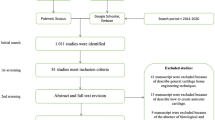Abstract
The purpose of the study was to examine the morphology and biomechanical characteristics of in vivo cultured tissue-engineered human septal cartilage as a prospective autogenous transplant material for subcutaneous implantation in reconstructive procedures. Chondrocytes were enzymatically isolated from human septal cartilage biopsies. The cell number was expanded in monolayer culture. Chondrocytes were then fixed on a non-woven poly-lactide-poly-glycolide (PGLA) polymer scaffold by means of fibrin glue. The PGLA-polymer construct was implanted subcutaneously on the back of athymic mice and allowed to mature for 6 or 12 weeks. After killing the mice, the formed cartilage was tested on a material testing machine with a highly standardized reproducible setting. Biomechanical testing consisted of an indentation test, which revealed the failure load and compressive modulus of the neocartilage. The failure load shows the upper limit of supported stress. The compressive modulus is a measure of the templates’ stiffness. After testing, the templates were histologically stained. Native human septal cartilage served as a control group. Histological and macroscopic examination showed cartilage formation of a hyaline-like morphology. Histological staining revealed the synthesis of abundant mucopolysaccharid matrix. The biomechanical characteristics of neocartilage proved to be of no statistical difference compared to native human septal cartilage. The failure load and compressive modulus were initially somewhat lower and reached the control group’s results after 12 weeks in-vivo. Summarizing, tissue engineered nasal cartilage matches typical mechanical characteristics of native hyaline cartilage. Its elasticity and failure load are of sufficient quality to meet the clinical requirements for reconstructive surgery.





Similar content being viewed by others
References
Langer R, Vacanti JP (1993) Tissue engineering. Science 260:920–926
Vacanti CA, Langer R, Schloo B, Vacanti JP (1991) Synthetic polymers seeded with chondrocytes provide a template for new cartilage formation. Plast Reconstr Surg 88:753–759
Haisch A, Schultz O, Perka C, Jahnke V, Burmester GR, Sittinger M (1996) Tissue engineering of human cartilage tissue for reconstructive surgery using biocompatible resorbable fibrin gel and polymer carriers. HNO 44:624–629
Sittinger M, Bujia J, Minuth WW, Hammer C, Burmester GR (1994) Engineering of cartilage tissue using bioresorbable polymer carries in perfusion culture. Biomaterials 15:451–456
Brunner FX (1993) Implant materials—what is applicable where and when? Eur Arch Otorhinolaryngol [Suppl] 1:311–336
Sittinger M, Braeunling J, Kastenbauer E, Hammer C, Burmester G, Bujia J (1997) Proliferative potential of human nasal chondrocytes in vitro culture of cartilage transplants. Laryngorhinootologie 76:96–100
Naumann A, Aigner J, Staudenmaier R, Seemann M, Bruening R, Englmeier KH, Kadegge G, Pavesio A, Kastenbauer E, Berghaus A (2003) Clinical aspects and strategy for biomaterial engineering of an auricle based on three-dimensional stereolithography. Eur Arch Otorhinolaryngol 260:568–575
Haisch A, Klaring S, Groger A, Gebert C, Sittinger M (2002) A tissue-engineering model for the manufacture of auricular-shaped cartilage implants. Eur Arch Otorhinolaryngol 259:316–321
Britt JC, Park SS (1998) Autogenous Tissue-engineered cartilage- Evaluation as an Implant Material. Arch Otolaryngol Head Neck Surg 124:671–677
Glasgold MJ, Kato YP, Christiansen D, Hauge JA, Glasgold AI, Silver FH (1988) Mechanical properties of septal cartilage homografts. Otolaryngol Head Neck Surg 99:374–379
Rotter N, Tobias G, Lebl M, Roy AK, Hansen MC, Vacanti CA, Bonassar LJ (2002) Age-related changes in the composition and mechanical properties of human nasal cartilage. Arch Biochem Biophys 403:132–140
Duda GN, Haisch A, Endres M, Gebert C, Schroeder D, Hoffmann JE, Sittinger M (2000) Mechanical quality of tissue engineered cartilage: results after 6 and 12 weeks in vivo. J Biomed Mater Res 53:673–677
Sittinger M, Bujia J, Minuth WW, Hammer C, Burmester GR (1996) Tissue engineering and autologous transplant formation: practical approaches with resorbable biomaterials and new cell culture techniques. Biomaterials 17:237–242
Rotter N, Bonassar LJ, Tobias G, Lebl M, Roy AK, Vacanti CA (2002) Age-dependence of biochemical and biomechanical properties of tissue-engineered human septal cartilage. Biomaterials 23:3087–3094
Ma PX, Schloo B, Mooney D, Langer R (1995) Development of biomechanical properties and morphogenesis of in vitro tissue engineered cartilage. J Biomed Mate Res 29:1587–1595
Freed LE, Langer R, Martin I, Pellis NR, and Vunjak-Novakovic G (1997) Tissue engineering of cartilage in space. Proc Natl Acad Sci USA 94:13885–13890
Mow VC, Kuei SC, Lai WM, Armstrong CG (1980) Biphasic creep and stress relaxation of articular cartilage in compression: theory and experiments. J Biomech Eng 102:73–84
Author information
Authors and Affiliations
Corresponding author
Rights and permissions
About this article
Cite this article
Haisch, A., Duda, G.N., Schroeder, D. et al. The morphology and biomechanical characteristics of subcutaneously implanted tissue-engineered human septal cartilage. Eur Arch Otorhinolaryngol 262, 993–997 (2005). https://doi.org/10.1007/s00405-005-0935-0
Received:
Accepted:
Published:
Issue Date:
DOI: https://doi.org/10.1007/s00405-005-0935-0




